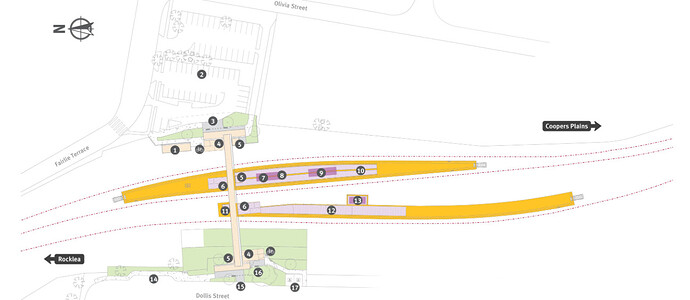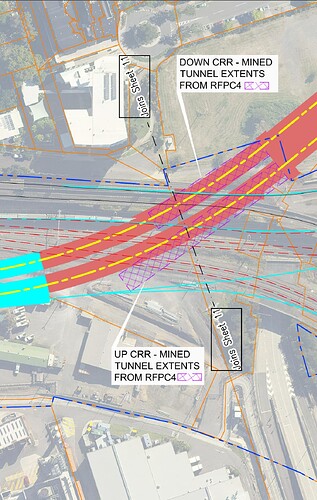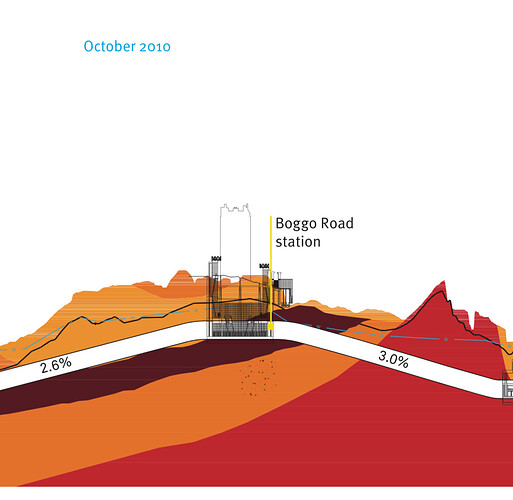So what are the options to fix this now CRR is built? Surface?
One surface option is a 4th track between Boggo Road and Kuraby. I don’t think that will eventuate though.
What would you suggest is done? Obviously that’s assuming there is the political will to…
There don’t seem to be any good options to fix it.
There’s no tunnel stubs built in, and there isn’t any space between the end of the platforms and the dive tunnels to install a crossover to stay underground, so you have to come back to the surface.
When you get to the surface, you immediately run into the Annerley Road Bridge. Whilst it is wide enough for 4 tracks underneath, it isn’t wide enough for 4 tracks and the Dutton Park Station. So you already have an issue about replacing the bridge or demolishing a brand new station.
Past Dutton Park, you may be able to squeeze a 4th track in the corridor through to Yeerongpilly (if road bridges at Venner Road and Cardos Street are replaced, and potentially some rail bridges as well), except you can’t fit a fourth line through Fairfield station, and it’s a bit tight through Yeronga (even with no platform on the 4th track). In any case, you would have to realign most of the track to make space for 4 tracks along the corridor. At least the corridor is wider from Yeerongpilly south so that shouldn’t be a problem.
With that in mind, you would have to decide if it is easier to just go around instead of doing all of that work in the existing corridor. CRR 1.0 considered this and found it was easier to just tunnel around (an opinion that was held in the Minerva report as well). You also have consider you would be doing works in a corridor that has just had years of works in it with no provision for an extra track.
If you do decide to tunnel around, there are very few opportunities to do that because of the topography and flooding issues. You also have to consider how far south you want to go before its no longer worth bypassing at all.
You may be able to get a new tunnel portal just south of the Annerley Road bridge, but that involves replacing the bridge, closing the station (or at least building another one), potentially impacting on the heritage listed park, and resuming about 34 parcels, some of which have units on them.
Alternatively, you could get a tunnel dive at Yeeronga School where the current car park is with only a few resumptions. But by then you are halfway to Yeerongpilly so you have to consider if its worth it.
The other matter is the CRR relies heavily on the Clapham Yard, so you also need to consider how to connect the yards to the southern portal.
TLDR There is no easy solution and Red Team’s lack of forward planning on ‘whats next’ make it very difficult to do the next step in this corridor.
If only they’d at the very least future proofed the rebuilt stations to allow for a fourth track.
Is it possible to build new tunnel to where tunnel stubs could have been built but not break the current tunnel wall to the last possible point in time and then create junction?
Messy and probably more expensive but there don’t seem to be many other options.
I don’t believe so, particularly not south of the Boggo Road platforms. The design drawings in the EIS have the tunnels at about 3% grade from the portal until basically the end of the platforms.
Someone who knows more about track geometry than me could probably give a more informed answer.
(screenshot from CRR website: Salisbury station accessibility rebuild update - Cross River Rail)
Since Salisbury station will be a junction station for the Beaudesert and Beenleigh/Gold Coast lines, do you reckon that the station upgrade for Salisbury station will involve an additional track and platform dedicated to Beaudesert trains?
Or would you reckon that they will keep the 3-platform layout of the junction, and keep the flat junction that is currently in place for the dual gauge line?
Ideally 4 tracks and platform arrangements to facilitate easy transfers.
Caveat. I don’t think there has been much thought about the impact of S2B rail on the corridor or station upgrades.
They probably see this as the next generation of planners problem
Ultimately this is a symptom of the tendency from both major parties to ‘value-engineer’ all of our PT infrastructure with no thought for future growth, expansion, or really even usage. No matter what we do the fix is going to be disruptive, messy, and really annoying for the general public.
I do wonder if it’s possible to rebuild the Annerley road bridge to add enough space to squeeze a 4th track through without having to demolish the brand new Boggo Rd station. This would be horrifically disruptive to the area for the entire length of it (given that it’s a major road corridor) but it may end up being easier than completely redoing the existing tunnel portal to try and squeeze a junction in.
Regardless I think the engineers are going to have a very rough time making this work, and the comms team is going to have an even harder one telling the general public that our brand new megaproject had a huge screw-up and we need to fix it.
If they don’t intend on building a 4th platform as Salisbury station, hopefully they will build a flying junction that branches off the eastern track and flies over the middle and western track to enter the Beaudesert line.
It would be extremely half-arsed if they keep the current flat junction rather than add any upgrades to the rail corridor at the Salisbury area.
With the stations that underwent major upgrades from Dutton Park to Salisbury, they pretty much have the 3-track corridor set in stone; the space for a potential 4th track has pretty much been taken up by the widened platforms.
Agree there just isn’t space on surface so all that seems to be left is a very expensive but I envisage engineering viable set of tunnels off the end of the Boggo Rd station.
What are the purple grids that briefly overlap the red shaded areas that are labelled ‘UP/DOWN CRR - MINED TUNNEL EXTENTS FROM RFPC4’?
They are the areas that were previously going to be mined (as approved under Request for Project Change 4) but are now (proposed/approved at the time of Request for Project Change 9) built as cut and cover.
The hatched area was not constructed.
These are the grades you’re working with immediately after leaving Boggo Road on the Up Track. Once the grade reaches 2.7% 85m from the end of the platform (55m from the end of the box), it continues at at least 2.7% through to the top of the portal/into the dive structure.
Guess the billion dollar questions is can a junction/turn out be built on these gradients?
Seems not recommended
Building a Turnout on a 2.6% Gradient
In most main-line and freight applications, a 2.6% (1 in 38.5) gradient through a turnout far exceeds accepted practice. Here’s a breakdown of why it’s problematic and what you can do if you absolutely must accommodate such a slope.
- Standard Limits and Guidelines
• Common Maximum Grades• Mainline freight: 0.5% – 1.0% (1 in 200 to 1 in 100)
• High-speed passenger: typically ≤ 0.4% (1 in 250)
• Industrial or low‐speed sidings: up to 1.5% in rare cases
• Why 2.6% Is Unusual• Trains accelerating or braking through points on steep grades risk wheel slip or insufficient braking distances.
• Turnout frogs and switch rails see uneven loading, increasing wear and derailment risk.
-
Engineering Challenges
-
Traction and Braking• Uphill: Locomotive tractive effort may be insufficient to move a long train through the turnout.
• Downhill: Reduced braking adhesion can lead to overruns or collisions. -
Maintenance and Wear• Switch rails and frogs on grades wear faster due to higher impact forces as cars shuffle.
-
Vehicle Dynamics• Steep grades amplify hunting oscillations and vertical lift on passing wheels, compromising stability.
- Mitigation Strategies
• Regrade the Alignment• Introduce a “transition” to flatten the track through the turnout to ≤ 1.0% whenever possible.
• Add Catch Points or Derailers• Protect mainline routes from runaway vehicles if gradient can’t be reduced.
• Use Sanding Systems• Provide extra wheel–rail adhesion during poor weather or heavy braking.
• Limit Turnout Length & Speed• Short, low-speed (e.g., 10 km/h) turnouts will suffer less wear and require less tractive effort.
- Example Configuration
Parameter Standard Practice At 2.6% Grade Scenario
Turnout speed limit 40 km/h (mainline) ≤ 10 km/h recommended
Maximum grade through frogs ≤ 1.0% 2.6% (requires special approvals)
Required transition length 30–50 m each end ≥ 100 m to taper grade
Risk category Moderate High (additional safety devices)
- Bottom Line
Building a turnout directly on a 2.6% gradient is strongly discouraged under most railway standards. If the site conditions absolutely demand it, you’ll need:
• Formal engineering approval from your regulatory body
• Enhanced safety installations (catch points, derailer, sanding)
• Lower turnout speeds and meticulous maintenance schedules
Before proceeding, engage a railway civil engineer to model traction, braking, and wear impacts, then verify that your operating rules can safely accommodate such a steep turnout.
Honestly I’m not even sure the trains are gonna be able to tackle the steep climb out of Boggo.
The fact that we haven’t seen any testing beyond Roma St really worries me.
The NGRs despite their historical DDA issues are very powerful units at low speed. They will be fine with the grades. QTMP trains will be equally capable as well.
For interest the tractive effort of a 3900 class electric locomotive is 2,890 kW (3,880 hp). The tractive effort of a six car NGR is 4,000 kW (16 traction motors, each rated at 250 kW).



